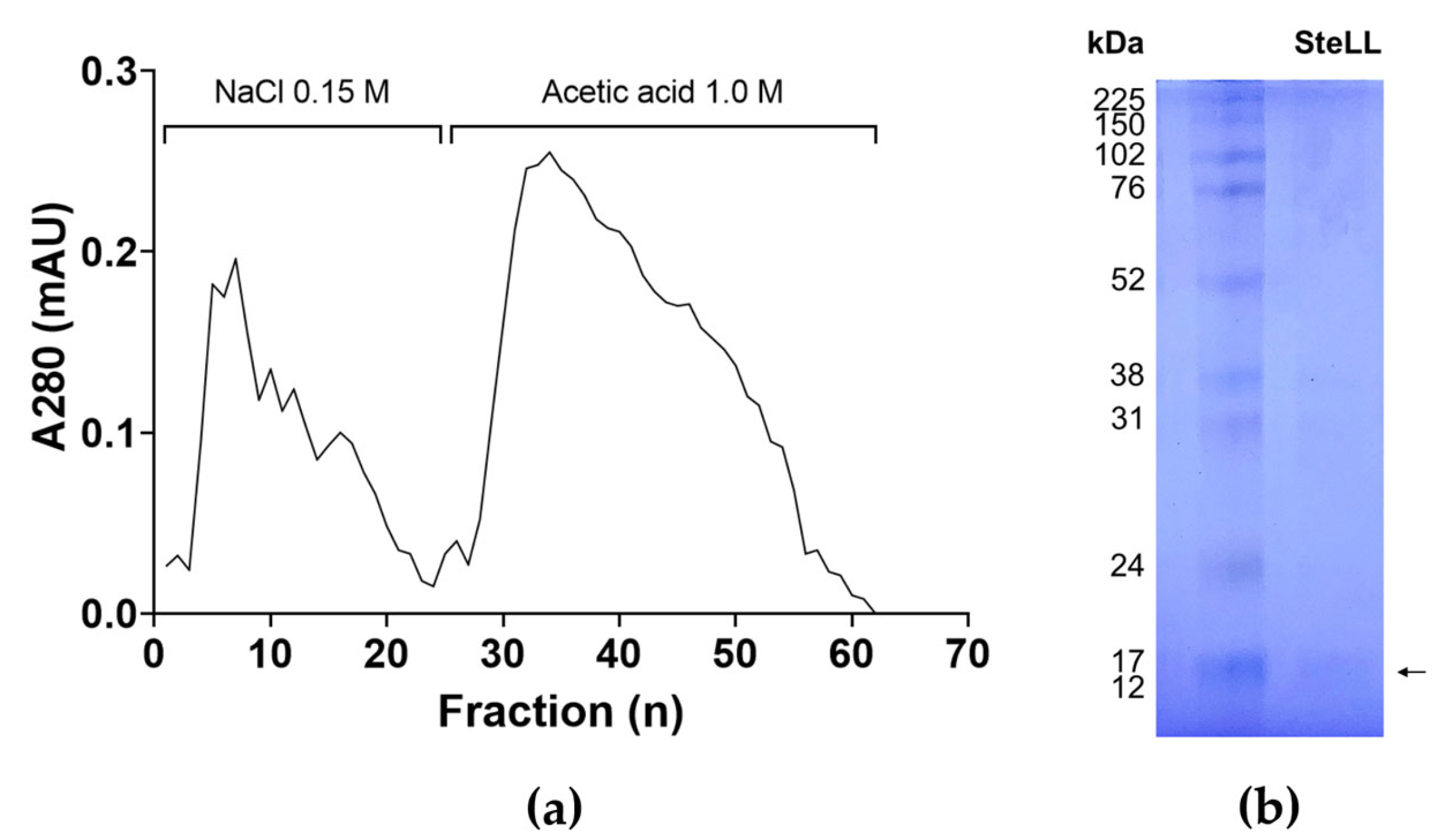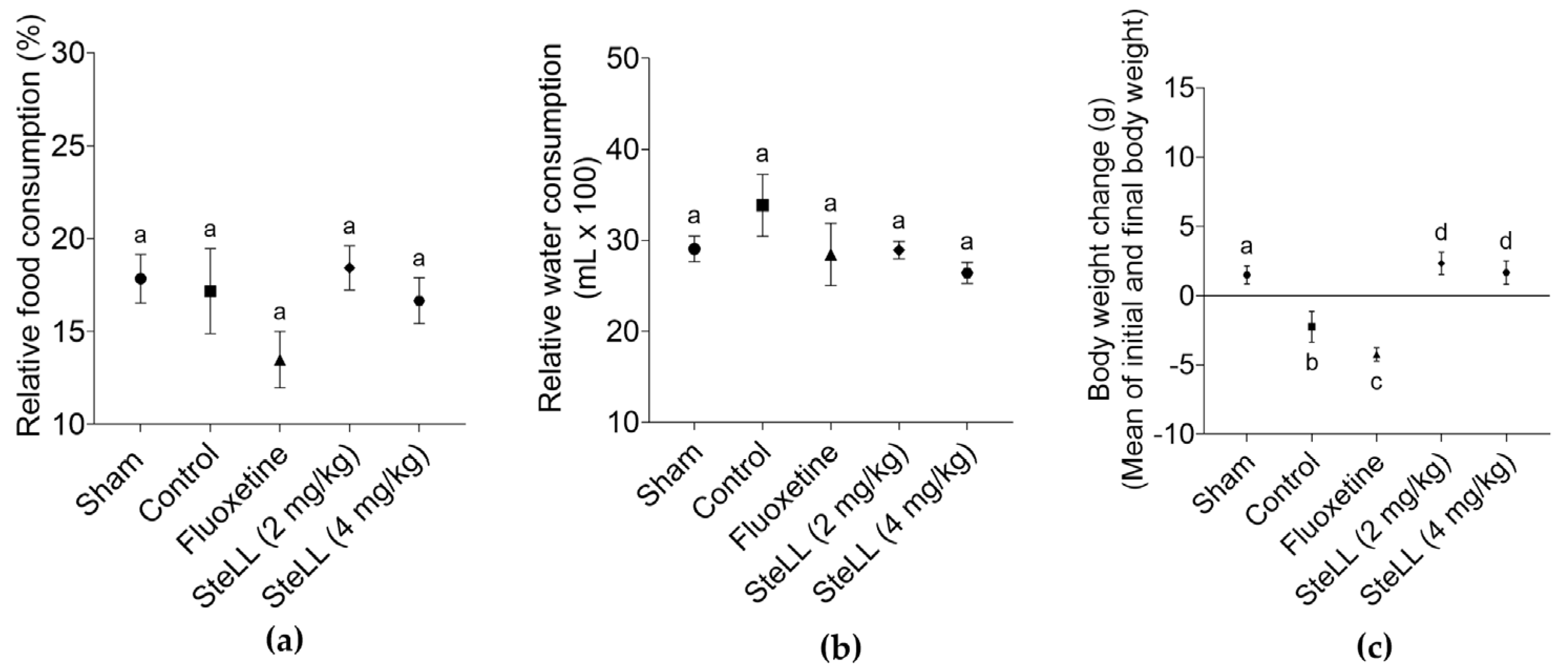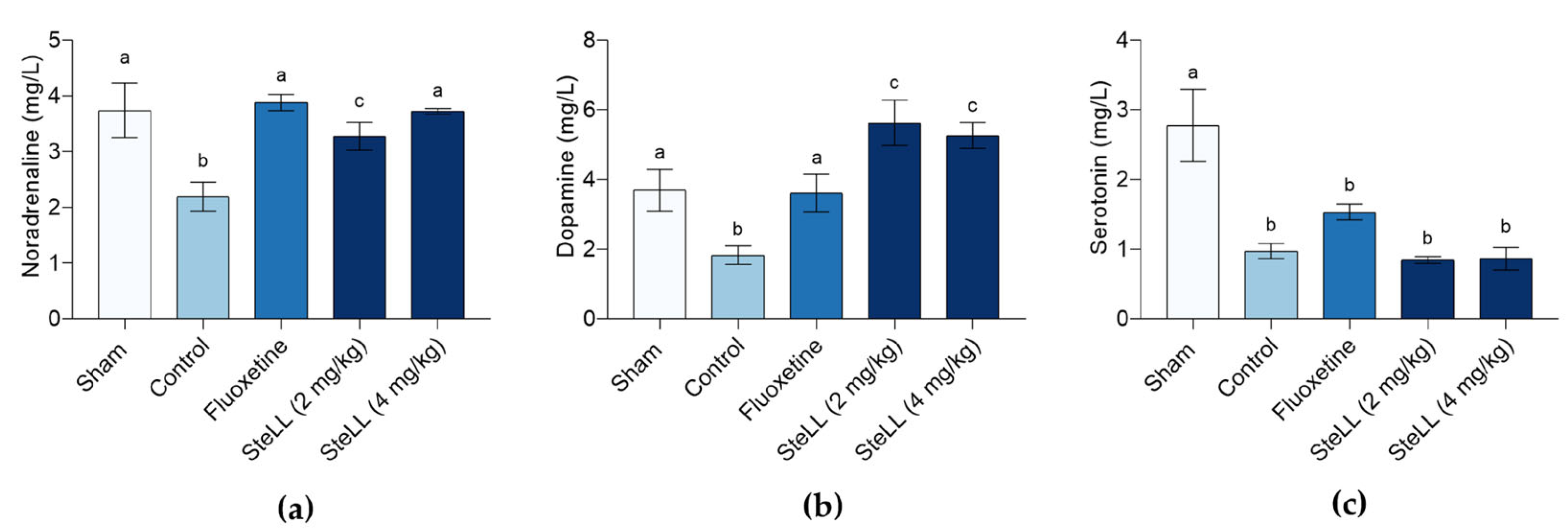Schinus terebinthifolia Raddi. Leaf Lectin (SteLL) Demonstrates Anxiolytic and Antidepressant Effects Under Monoaminergic Deficiency Induced by Reserpine
Abstract
1. Introduction
2. Results
2.1. Purification of SteLL
2.2. Administration of SteLL Displayed Anxiolytic-Like Effects in Reserpine-Treated Mice
2.3. SteLL Reduced Immobility Time in the Tail Suspension Test (TST)
2.4. SteLL Treatment Prevented the Weight Loss Effects Caused by Reserpine Administration
2.5. Effect of SteLL on Brain Cytokine Levels in the Reserpine Model
2.6. SteLL Ameliorated Monoaminergic Signaling Following Reserpine Treatment
3. Discussion
4. Materials and Methods
4.1. Lectin Purification
4.2. Animals
4.3. Reserpine Protocol and Treatments
4.4. Open Field Test (OFT)
4.5. Elevated Plus Maze (EPM) Test
4.6. Tail Suspension Test (TST)
4.7. Body Weight and Chemical Parameters
4.7.1. Monitoring of Body Weight and Consumption of Food and Water
4.7.2. Brain Dissection
4.7.3. Cytokine Quantification
4.7.4. Monoamine Quantification
4.8. Statistical Analysis
5. Conclusions
Author Contributions
Funding
Institutional Review Board Statement
Data Availability Statement
Conflicts of Interest
References
- Crocq, M.A. A history of anxiety: From Hippocrates to DSM. Dialogues Clin. Neurosci. 2015, 17, 319–325. [Google Scholar] [CrossRef]
- Muskin, P.R. What Are Anxiety Disorders? American Psychiatric Association: Washington, DC, USA, 2023. Available online: https://www.psychiatry.org/patients-families/anxiety-disorders/what-are-anxiety-disorders/ (accessed on 22 June 2025).
- Bhatt, S.; Behl, T.; Sehgal, A.; Singh, S.; Sharma, N.; Chigurupati, S.; Ahmed, A.S.; Gari, S.B.V. Investigation of Cochlospermum religiosum leaves for antidepressant and anxiolytic activities and its synergistic effect with imipramine and fluoxetine. Environ. Sci. Pollut. Res. Int. 2022, 29, 27172–27181. [Google Scholar] [CrossRef]
- World Health Organization (WHO). COVID-19 Pandemic Triggers 25% Increase in Prevalence of Anxiety and Depression Worldwide. WHO 2022. Available online: https://www.who.int/news/item/02-03-2022-covid-19-pandemic-triggers-25-increase-in-prevalence-of-anxiety-and-depression-worldwide (accessed on 22 June 2025).
- Kim, Y.R.; Park, B.K.; Seo, C.S.; Kim, N.S.; Lee, M.Y. Antidepressant and anxiolytic-like effects of the stem bark extract of Fraxinus rhynchophylla Hance and its components in a mouse model of depressive-like disorder induced by reserpine administration. Front. Behav. Neurosci. 2021, 15, 650833. [Google Scholar] [CrossRef]
- Foudah, A.I.; Alqarni, M.H.; Alam, A.; Devi, S.; Salkini, M.A.; Alam, P. Rutin improves anxiety and reserpine-induced depression in rats. Molecules 2022, 27, 7313. [Google Scholar] [CrossRef] [PubMed]
- Kraus, S.I.; Ferreira, J.B.; França, A.P.; Wippel, V.A.; Leal, R.B.; Oppermann, R.; Alberton, M.D.; Silva, M.D. Pharmacological evidence of Eugenia brasiliensis leaves in a reserpine-induced fibromyalgia model: Antinociceptive, emotional, anti-inflammatory, and neurotrophic effects. Mol. Neurobiol. 2024, 61, 9402–9415. [Google Scholar] [CrossRef] [PubMed]
- Tsaneva, M.; Van Damme, E.J.M. 130 years of plant lectin research. Glycoconj. J. 2020, 37, 533–551. [Google Scholar] [CrossRef] [PubMed]
- Gundidza, M.; Gweru, N.; Magwa, M.L.; Mmbengwa, V.; Samie, A. The chemical composition and biological activities of essential oil from the fresh leaves of Schinus terebinthifolius from Zimbabwe. Afr. J. Biotechnol. 2009, 8, 7164–7169. [Google Scholar]
- Patocka, J.; Almeida, J.D. Brazilian pepper tree: Review of pharmacology. Mil. Med. Sci. Lett. 2017, 86, 32–41. [Google Scholar] [CrossRef]
- Ramos, D.B.M.; Araújo, M.T.M.F.; Araújo, T.C.L.; Santos Neto, O.G.; Silva, M.G.; Silva, Y.A.; Torres, D.J.L.; Patriota, L.L.S.; Melo, C.M.L.; Lorena, V.M.B.; et al. Evaluation of antitumor activity and toxicity of Schinus terebinthifolia leaf extract and lectin (SteLL) in sarcoma 180-bearing mice. J. Ethnopharmacol. 2019, 233, 148–157. [Google Scholar] [CrossRef]
- Marinho, A.O.; Costa, J.A.; Santos, A.N.S.; Barros, M.C.; Pimentel, C.D.N.; Silva, A.A.; Paiva, P.M.G.; Napoleão, T.H.; Patriota, L.L.S. Assessment of acute toxicity, genotoxicity, and anti-inflammatory activity of SteLL, a lectin from Schinus terebinthifolia Raddi. Leaves, in mice. J. Ethnopharmacol. 2024, 333, 118496. [Google Scholar] [CrossRef]
- Lima, B.R.F.; Patriota, L.L.S.; Marinho, A.O.; Costa, J.A.; Napoleão, T.H.; Rosa, M.M.; Paiva, P.M.G. The anxiolytic activity of Schinus terebinthifolia leaf lectin (SteLL) is dependent on monoaminergic signaling although independent of the carbohydrate-binding domain of the lectin. Pharmaceuticals 2022, 15, 1364. [Google Scholar] [CrossRef]
- Lima, B.R.F.; Patriota, L.L.S.; Marinho, A.O.; Costa, J.A.; Napoleão, T.H.; Rosa, M.M.; Paiva, P.M.G. The lectin from Schinus terebinthifolia leaf (SteLL) reduces immobility of mice on the tail suspension test dependent on the monoaminergic and nitric oxide signaling. Neurosci. Lett. 2023, 801, 137092. [Google Scholar] [CrossRef] [PubMed]
- Lima, B.R.F.; Patriota, L.L.S.; Marinho, A.O.; Costa, J.A.; Ribeiro, B.G.; Santos, V.B.S.; Napoleão, D.C.; Cavalcanti, J.V.F.L.; Vieira, L.D.; Pereira, M.C.; et al. Subacute symptoms of depression and anxiety in stress-exposed mice: Role of Schinus terebinthifolia Raddi leaf lectin (SteLL). J. Ethnopharmacol. 2025, 341, 119343. [Google Scholar] [CrossRef] [PubMed]
- Gomes, F.S.; Procópio, T.F.; Napoleão, T.H.; Coelho, L.C.B.B.; Paiva, P.M.G. Antimicrobial lectin from Schinus terebinthifolius leaf. J. Appl. Microbiol. 2013, 114, 672–679. [Google Scholar] [CrossRef] [PubMed]
- Santos, A.J.C.A.; Barros, B.R.S.; Aguiar, L.M.S.; Patriota, L.L.S.; Lima, T.A.; Zingali, R.B.; Paiva, P.M.G.; Napoleão, T.H.; Melo, C.M.L.; Pontual, E.V. Schinus terebinthifolia leaf lectin (SteLL) is an immunomodulatory agent by altering cytokine release by mice splenocytes. 3 Biotech 2020, 10, 144. [Google Scholar] [CrossRef]
- Reinhardt, P.R.; Theis, C.D.C.; Juckel, G.; Freund, N. Rodent models for mood disorders—Understanding molecular changes by investigating social behavior. Biol. Chem. 2023, 404, 939–950. [Google Scholar] [CrossRef]
- Bremshey, S.; Groß, J.; Renken, K.; Masseck, O.A. The role of serotonin in depression—A historical roundup and future directions. J. Neurochem. 2024, 168, 1751–1779. [Google Scholar] [CrossRef]
- Strawbridge, R.; Javed, R.R.; Cave, J.; Jauhar, S.; Young, A.H. The effects of reserpine on depression: A systematic review. J. Psychopharmacol. 2023, 37, 248–260. [Google Scholar] [CrossRef]
- Wu, D.; Chen, Q.; Yu, Z.; Huang, B.; Zhao, J.; Wang, Y.; Su, J.; Zhou, F.; Yan, R.; Li, N.; et al. Transport and inhibition mechanisms of human VMAT2. Nature 2024, 626, 427–434. [Google Scholar] [CrossRef]
- Moon, J.H.; Oh, C.M.; Kim, H. Serotonin in the regulation of systemic energy metabolism. J. Diabetes Investig. 2022, 13, 1639–1645. [Google Scholar] [CrossRef]
- Chakravarthy, S.; Balasubramani, P.P.; Mandali, A.; Jahanshahi, M.; Moustafa, A.A. The many facets of dopamine: Toward an integrative theory of the role of dopamine in managing the body’s energy resources. Physiol. Behav. 2018, 195, 128–141. [Google Scholar] [CrossRef] [PubMed]
- Holland, N.; Robbins, T.W.; Rowe, J.B. The role of noradrenaline in cognition and cognitive disorders. Brain 2021, 144, 2243–2256. [Google Scholar] [CrossRef] [PubMed]
- Zhao, J.; Shi, W.; Lu, Y.; Gao, X.; Wang, A.; Zhang, S.; Du, Y.; Wang, Y.; Li, L. Alterations of monoamine neurotransmitters, HPA-axis hormones, and inflammation cytokines in reserpine-induced hyperalgesia and depression comorbidity rat model. BMC Psychiatry 2022, 22, 419. [Google Scholar] [CrossRef] [PubMed]
- Kraeuter, A.K.; Guest, P.C.; Sarnyai, Z. The Elevated Plus Maze Test for measuring anxiety-like behavior in rodents. Methods Mol. Biol. 2019, 1916, 69–74. [Google Scholar]
- Armah, F.A.; Henneh, I.T.; Amponsah, I.K.; Biney, R.P.; Malcolm, F.; Alake, J.; Ahlidja, W.; Ahmed, M.A.; Adokoh, C.K.; Adukpo, G.E.; et al. Antidepressant and anxiolytic effects and subacute toxicity of the aerial parts of Psychotria ankasensis J.B.Hall (Rubiaceae) in murine models. Evid.-Based Complement. Altern. Med. 2021, 2021, 5543320. [Google Scholar] [CrossRef]
- Patriota, L.L.S.; Lima, B.R.F.; Marinho, A.O.; Costa, J.A.; Coelho, L.C.B.B.; Rêgo, M.J.B.M.; Pitta, M.G.R.; Paiva, P.M.G.; Pereira, M.C.; Napoleão, T.H.; et al. Water-soluble Moringa oleifera Seed Lectin Exhibits Monoaminergic Pathway-linked Anti-depressive-like Effects in Mice. Prot. Pept. Lett. 2023, 30, 1048–1057. [Google Scholar] [CrossRef]
- Gronemann, F.H.; Petersen, J.; Alulis, S.; Jensen, K.J.; Riise, J.; Ankarfeldt, M.Z.; Solem, E.J.; Bødker, N.; Osler, M. Treatment patterns in patients with treatment-resistant depression in Danish patients with major depressive disorder. J. Affect. Disord. 2021, 287, 204–213. [Google Scholar] [CrossRef]
- Al-Harbi, K.S. Treatment-resistant depression: Therapeutic trends, challenges, and future directions. Patient Prefer. Adherence 2012, 6, 369–388. [Google Scholar] [CrossRef]
- Zheng, G.; Xue, W.; Wang, P.; Yang, F.; Li, B.; Li, X.; Li, Y.; Yao, X.; Zhu, F. Exploring the inhibitory mechanism of approved selective norepinephrine reuptake inhibitors and reboxetine enantiomers by molecular dynamics study. Sci. Rep. 2016, 6, 26883. [Google Scholar] [CrossRef]
- Shenoi, S.D.; Soman, S.; Munoli, R.; Prabhu, S. Update on pharmacotherapy in psychodermatological disorders. Indian Dermatol. Online J. 2020, 11, 307–318. [Google Scholar] [CrossRef]
- Li, Z.; Tong, X.; Ma, Y.; Bao, T.; Yue, J. Prevalence of depression in patients with sarcopenia and correlation between the two diseases: Systematic review and meta-analysis. J. Cachexia Sarcopenia Muscle 2022, 13, 128–144. [Google Scholar] [CrossRef]
- Zakaria, F.H.; Samhani, I.; Mustafa, M.Z.; Shafin, N. Pathophysiology of depression: Stingless bee honey promising as an antidepressant. Molecules 2022, 27, 5091. [Google Scholar] [CrossRef] [PubMed]
- Worthen, R.J.; Zighelboim, S.S.G.; Jaramillo, C.S.T.; Beurel, E. Anti-inflammatory IL-10 administration rescues depression-associated learning and memory deficits in mice. J. Neuroinflammation 2020, 17, 246. [Google Scholar] [CrossRef] [PubMed]
- Bai, Y.; Cai, Y.; Chang, D.; Li, D.; Huo, X.; Zhu, T. Immunotherapy for depression: Recent insights and future targets. Pharmacol. Ther. 2024, 257, 108624. [Google Scholar] [CrossRef] [PubMed]
- Cui, L.; Li, S.; Wang, S.; Wu, X.; Liu, Y.; Yu, W.; Wang, Y.; Tang, Y.; Xia, M.; Li, B. Major depressive disorder: Hypothesis, mechanism, prevention and treatment. Signal Transduct. Target. Ther. 2024, 9, 30. [Google Scholar] [CrossRef]
- Yin, Y.; Ju, T.; Zeng, D.; Duan, F.; Zhu, Y.; Liu, J.; Li, Y.; Lu, W. “Inflamed” depression: A review of the interactions between depression and inflammation and current anti-inflammatory strategies for depression. Pharmacol. Res. 2024, 207, 107322. [Google Scholar] [CrossRef]
- Alami, M.; Boumezough, K.; Zerif, E.; Zoubdane, N.; Khalil, A.; Bunt, T.; Laurent, B.; Witkowski, J.M.; Ramassamy, C.; Boulbaroud, S.; et al. In vitro assessment of the neuroprotective effects of pomegranate (Punica granatum L.) polyphenols against tau phosphorylation, neuroinflammation, and oxidative stress. Nutrients 2024, 16, 3667. [Google Scholar] [CrossRef]
- Euteneuer, F.; Dannehl, K.; Del Rey, A.; Engler, H.; Schedlowski, M.; Rief, W. Immunological effects of behavioral activation with exercise in major depression: An exploratory randomized controlled trial. Transl. Psychiatry 2017, 7, e1132. [Google Scholar] [CrossRef]
- Zhang, H.Y.; Wang, Y.; He, Y.; Wang, T.; Huang, X.H.; Zhao, C.M.; Zhang, L.; Li, S.W.; Wang, C.; Qu, Y.N.; et al. A1 astrocytes contribute to murine depression-like behavior and cognitive dysfunction, which can be alleviated by IL-10 or fluorocitrate treatment. J. Neuroinflammation 2020, 17, 200. [Google Scholar] [CrossRef]
- Natarajan, R.; Northrop, N.A.; Yamamoto, B.K. Protracted effects of chronic stress on serotonin-dependent thermoregulation. Stress 2015, 18, 668–676. [Google Scholar] [CrossRef]
- Pereira, A.C.; Carvalho, M.C.; Padovan, C.M. Both serotonergic and noradrenergic systems modulate the development of tolerance to chronic stress in rats with lesions of the serotonergic neurons of the median raphe nucleus. Behav. Brain Res. 2019, 14, 39–47. [Google Scholar] [CrossRef] [PubMed]
- Ressler, K.J.; Nemeroff, C.B. Role of norepinephrine in the pathophysiology and treatment of mood disorders. Biol. Psychiatry 1999, 46, 1219–1233. [Google Scholar] [CrossRef] [PubMed]
- Laemmli, U.K. Cleavage of structural proteins during the assembly of the head of bacteriophage T4. Nature 1970, 227, 680–685. [Google Scholar] [CrossRef] [PubMed]
- Lowry, O.H.; Rosebrough, N.J.; Farr, A.L.; Randall, R.J. Protein measurement with the Folin phenol reagent. J. Biol. Chem. 1951, 193, 265–275. [Google Scholar] [CrossRef]
- Procópio, T.F.; Patriota, L.L.S.; Moura, M.C.; Silva, P.M.; Oliveira, A.P.S.; Carvalho, L.V.N.; Lima, T.A.; Soares, T.; Silva, T.D.; Coelho, L.C.B.B.; et al. CasuL: A new lectin isolated from Calliandra surinamensis leaf pinnulae with cytotoxicity to cancer cells, antimicrobial activity and antibiofilm effect. Int. J. Biol. Macromol. 2017, 98, 419–429. [Google Scholar] [CrossRef]
- Neto, J.D.N.; Almeida, A.A.; Oliveira, J.S.; Santos, P.S.; Sousa, D.P.; Freitas, R.M. Antioxidant effects of nerolidol in mice hippocampus after open field test. Neurochem. Res. 2013, 38, 1861–1870. [Google Scholar] [CrossRef]
- Hernandez-Leon, A.; Escamilla-Orozco, R.I.; Tabal-Robles, A.R.; Martínez-Vargas, D.; Romero-Bautista, L.; Escamilla-Soto, G.; González-Romero, O.S.; Torres-Valencia, M.; González-Trujano, M.E. Antidepressant- and anxiolytic-like activities and acute toxicity evaluation of the Psilocybe cubensis mushroom in experimental models in mice. J. Ethnopharmacol. 2024, 320, 117415. [Google Scholar] [CrossRef]
- Moreno-Santos, B.; Marchi-Coelho, C.; Costa-Ferreira, W.; Crestani, C.C. Angiotensinergic receptors in the medial amygdaloid nucleus differently modulate behavioral responses in the elevated plus-maze and forced swimming test in rats. Behav. Brain Res. 2021, 397, 112947. [Google Scholar] [CrossRef]
- Reis-Silva, T.M.; Sandini, T.M.; Calefi, A.S.; Orlando, B.C.G.; Moreira, N.; Lima, A.P.N.; Florio, J.C.; Queiroz-Hazarbassanov, N.G.T.; Bernardi, M.M. Stress resilience evidenced by grooming behaviour and dopamine levels in male mice selected for high and low immobility using the tail suspension test. Eur. J. Neurosci. 2019, 50, 2942–2954. [Google Scholar] [CrossRef]
- Sharma, S.; Handu, S.; Dubey, A.K.; Sharma, P.; Mediratta, P.; Ahmed, Q.M. Antianxiety and anti-depressant-like effects of Murraya koenigii in experimental models of anxiety and depression. Anc. Sci. Life 2017, 36, 215–219. [Google Scholar]







Disclaimer/Publisher’s Note: The statements, opinions and data contained in all publications are solely those of the individual author(s) and contributor(s) and not of MDPI and/or the editor(s). MDPI and/or the editor(s) disclaim responsibility for any injury to people or property resulting from any ideas, methods, instructions or products referred to in the content. |
© 2025 by the authors. Licensee MDPI, Basel, Switzerland. This article is an open access article distributed under the terms and conditions of the Creative Commons Attribution (CC BY) license (https://creativecommons.org/licenses/by/4.0/).
Share and Cite
Lima, B.R.F.d.; Patriota, L.L.d.S.; Marinho, A.d.O.; Lira, T.L.d.S.; Costa, J.A.d.; Ribeiro, B.G.; Napoleão, D.C.; Cavalcanti, J.V.F.L.; Pereira, M.C.; Rego, M.J.B.d.M.; et al. Schinus terebinthifolia Raddi. Leaf Lectin (SteLL) Demonstrates Anxiolytic and Antidepressant Effects Under Monoaminergic Deficiency Induced by Reserpine. Plants 2025, 14, 3048. https://doi.org/10.3390/plants14193048
Lima BRFd, Patriota LLdS, Marinho AdO, Lira TLdS, Costa JAd, Ribeiro BG, Napoleão DC, Cavalcanti JVFL, Pereira MC, Rego MJBdM, et al. Schinus terebinthifolia Raddi. Leaf Lectin (SteLL) Demonstrates Anxiolytic and Antidepressant Effects Under Monoaminergic Deficiency Induced by Reserpine. Plants. 2025; 14(19):3048. https://doi.org/10.3390/plants14193048
Chicago/Turabian StyleLima, Bárbara Raíssa Ferreira de, Leydianne Leite de Siqueira Patriota, Amanda de Oliveira Marinho, Thiago Lucas da Silva Lira, Jainaldo Alves da Costa, Beatriz Galdino Ribeiro, Daniella Carla Napoleão, Jorge Vinícius Fernandes Lima Cavalcanti, Michelly Cristiny Pereira, Moacyr Jesus Barreto de Melo Rego, and et al. 2025. "Schinus terebinthifolia Raddi. Leaf Lectin (SteLL) Demonstrates Anxiolytic and Antidepressant Effects Under Monoaminergic Deficiency Induced by Reserpine" Plants 14, no. 19: 3048. https://doi.org/10.3390/plants14193048
APA StyleLima, B. R. F. d., Patriota, L. L. d. S., Marinho, A. d. O., Lira, T. L. d. S., Costa, J. A. d., Ribeiro, B. G., Napoleão, D. C., Cavalcanti, J. V. F. L., Pereira, M. C., Rego, M. J. B. d. M., Pitta, M. G. d. R., Napoleão, T. H., da Rosa, M. M., & Paiva, P. M. G. (2025). Schinus terebinthifolia Raddi. Leaf Lectin (SteLL) Demonstrates Anxiolytic and Antidepressant Effects Under Monoaminergic Deficiency Induced by Reserpine. Plants, 14(19), 3048. https://doi.org/10.3390/plants14193048





